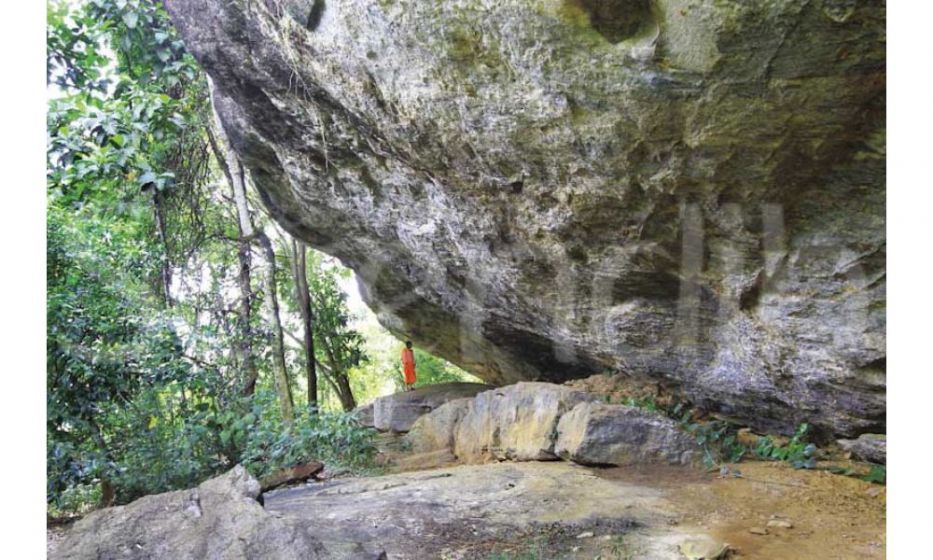
Alawala Caves or Alawala Pothgul Lena
Who is Pre-Historic Man ?
Pre-historic man is a man who hunted and gathered to provide food for his family during the stone.
Alawala Pre Historic Cave
Balangoda man is an example for prehistoric man who lived in Sri Lanka. Excavations conducted at Alawala pre-historic caves or Pothgul Lena revealed that prehistoric man had inhabited this cave which is located within the Alawala Raja Maha Viharaya (Buddhist Temple) in Attanagalla of Gampaha District, Sri Lanka.
Carbon dating pronounced that the cave inhabitants may have lived there for more than 14,000 years before present (BP). Evidence of Alawala displays similarity to findings from Bulathsinghala Fahien Cave (dated 38,000 BP), Kuruwita Batadombalena (dated 38,000 BP) and of Kitulgala Beli Lena dated 31,000. The excavations were conducted by the Postgraduate institute of Archaeology with the participation of students of many of the Universities in Sri Lanka. This project obtained partial funding from the Ministry of Environment. In appearance Balangoda man (or Mesolithic man) resembles modern man. But, modern genetics disclose that the Balangoda man is similar to the Veddahs.
Artefacts of Pre Historic Man
Balangoda man utilized quartz and chert to manufacture artefacts to assist him to carry out his daily activities. The hunted animals were roasted on a fire before consuming. The excavations revealed bone fragments and teeth of hunted an charred animals; stone artefacts, bone artefacts; evidence of burial after death; adornment of ornaments, graphite, chert and other.
Food habits of Alawala Cave Pre Historic Man
The prehistoric man living at Alawala. consumed a wide variety of food. Bone fragment analysis revealed mice, bats, porcupine, giant squirrel, flying squirrel, rats, civets, monkeys, mouse deer, hog deer, wild boar, sambar, barking deer, tortoise and lizards as part of his diet. Besides these, evidence revealed that he had brought Gal Veralu (Elaeocarpus sp.) and Thel kekuna (Canarium zeylanicum) to the cave. Furthermore, thousands of shell remains indicated that he had gathered tree snails (Acavus sp) and freshwater snails for consumption as well.
Burial Rituals of Pre Historic Man
The prehistoric man who lived at Alawala observed burial rituals. After death, the body was kept aside for decomposition. Thereafter, the skull was painted with other and buried. The inhabitants of Alawaia had visited the coast and brought back many shells including a shark tooth. This was crafted as a pendant by drilling a hole in it. This can be considered as an exemplary artistic creation. Shell beads indicated that these were adorned as a form of jewellery.
One of the most important findings of Alawala is the presence of a tooth and finger digit belonging to a Tiger. The Tiger is the largest member of the cat family. Excavations conducted in the wet zone manifest the presence and extinction of Tigers between 17,000 to 13,000 BP in Sri Lanka. The motive for bearing Tiger remains to the cave cannot be understood.
Religious Witnesses of Alawala caves
The inscriptions carved in the wall of the Alawala cave Pothgul Lena indicates that this has been a religious centre which had spread the light of Buddhism in the pre and post historic period and the establishment of a monastery at Alawala. The inscriptions describe the leadership of the Gamika's (village leader) and of a stream that runs through the forest. Cave deposits do not read about the culture and anthropogenic informatics about the ages between the prehistoric and proto historic period since these cultural stratifications have been removed by villagers for use as fertilizer. Therefore, the history of the inhabitants of Alawala is disturbed and cannot be read continuously.
However, whatever that remains speaks of the rich history of the inhabitants of Sri Lanka from the stone age to the present day and weaves a story of their life and our heritage.
Reference
-
Post Graduate Institute of Archelogy Sri Lanka (PGIR Colombo)
-
Biodiversity Secretaries – Minsitry of Environment
- Towards Awlawala Cave by Prof Gamini Adikari & Mr. Kelum Manamendra Arachchi